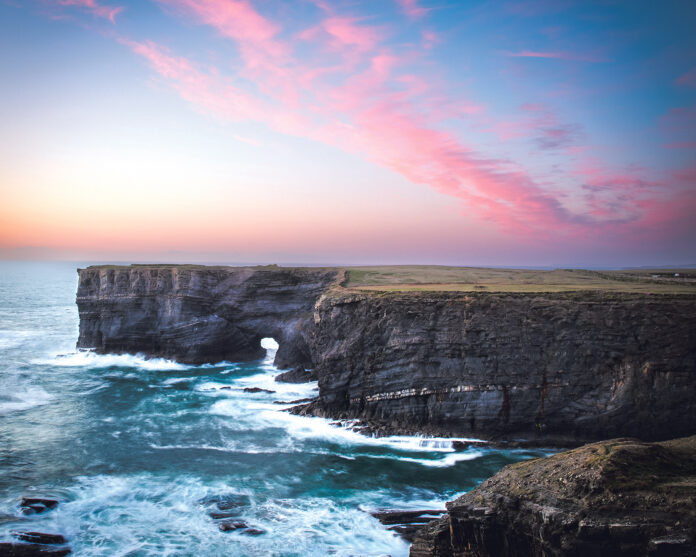GEOLOGIST and photographer, Robert Fairfield feels like a detective when he examines a rock. – “When I pick up a rock, it tells me a story. Like a detective, I look at it and see how did this rock get here.”
Thanks to his geology training, Mr Fairfield can categorise most rocks into a particular era, but uses a more detailed analysis with specific tools to confirm their precise origin and date.
“If I pick up a piece of volcanic rock, I know it came from a volcano. If I pick up a piece of limestone, I know it came from the sea. If there are fossils in it, I know it came from a coral reef,” he said.
Recently, combining his two passions – geology and photography – helped him to scoop the runners-up prize in the Irish Geological Survey’s 2022 Du Noyer Photographic Competition.
Each year, Geological Survey Ireland holds a photo competition in honour of George Victor Du Noyer, who lived from 1817-1869, an Irish geologist, artist and antiquary.
Du Noyer began working for the Survey in 1848, and was a prolific documenter of geological landscapes, both via his work in mapping and geology, and in his vivid and detailed watercolours and sketches.
Mr Fairfield’s photograph near Loop Head Lighthouse shows beds of sandstone and siltstone deposited during the Carboniferous Period – 359 to 299 million years. Beds show some cross-bedding and the erosion of a sea arch.
“I often go to Loop Head to take photographs. I think the Kilkee Cliffs and the stretch between Kilkee and Loop Head Lighthouse rival the Cliffs of Moher.
“I am a trained geologist and this particular location stood out for me. I have probably taken 3,000 or 4,000 photographs of the Kilkee Cliffs.
“I like to take photographs there in the afternoon when the sun is setting in the West and the sun is low in the sky during the winter.”
He was delighted his photograph scooped the runners-up prize in the photographic competition.
“I was looking for a Christmas order in my junk mail folder when I saw the announcement that I had won a runners-up award.
“The awards ceremony was the previous Friday, so I missed it. The Geological Survey Ireland had invited me to visit their headquarters in Dublin,” he said.
Mr Fairfield previously worked for United States Geological Survey before he went into teaching.
Born in Colorado, USA, in 1960, Mr Fairfield completed a geology degree in the University of Colorado before he received a teaching certificate.
Working in the US until he was 30 years old, he went to Zambia where he taught in the American Embassy School for eight years, moved to Philadelphia for a few years, Texas for 12 years and ended up coming to live in Killaloe in 2015.
His interest in geology goes back to his school days.
“When a teacher brought in a box of rocks, I was absolutely fascinated. My father and I joined a rock collecting club. Colorado is a well-known mining state. We would spend our summers driving around collecting rocks. That sparked my interest to go into geology,” he explained.
After moving to South-East Clare, Mr Fairfield (62) researched the local geology and spoke to people about different rock formations.
Visiting the Burren to take numerous photographs four or five times a year, Doolin is his favourite location with its eclectic mix of the cliffs, Burren landscape and the sea.
“I love going to Doolin during the winter when the light is so much better for taking photographs. The warm light tends to cast long shadows. The light can be very flat during the summer.
A regular visitor to the Burren, he believes the limestone landscape is unique in Europe.
“The Burren is a remanent of an ecological time. There are pockets with plants that have been there since glacial times.”
Asked about the contentious issue of fracking, Mr Fairfield said mining is safe in some places like Dakota in the USA where it is miles deep.
However, in locations like East Clare, he stressed environmental studies have to prove that there is no risk of groundwater contamination before mining can be considered.
“I tell my students unless you can grow something, you have to mine it,” he said.
He has given geology presentations in school where children examined different rocks he brought in a box. He believes it is important for schools to include practical examples of geology in geography classes.
“If you look at the front page of a newspaper, more than likely there will be an earth science story somewhere. It could be a tsunami, hurricane, flooding or a volcano.
He is co-founder of the Killaloe Photography Group and runs Buffalo Studios Ireland with his partner, Siobhan Cahill.
They display and sell photographs in the Bridge Studio, Ballina, Killaloe, other retail locations and on line.
Founded in 1845, Geological Survey Ireland is Ireland’s public earth science knowledge centre and is a division of the Department of the Environment, Climate and Communications.
East Clare correspondent, Dan Danaher is a journalism graduate of Rathmines and UL. He has won numerous awards for special investigations on health, justice, environment, and reports on news, agriculture, disability, mental health and community.


